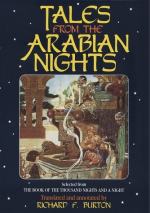All this, with due deference to so high an authority, is very superficial. Granted, which nobody denies, that the archetypal Hazar Afsanah was translated from Persic into Arabic nearly a thousand years ago, it had ample time and verge enough to assume another and a foreign dress, the corpus however remaining untouched. Under the hands of a host of editors, scribes and copyists, who have no scruples anent changing words, names and dates, abridging descriptions and attaching their own decorations, the florid and rhetorical Persian would readily be converted into the straight-forward, business-like, matter of fact Arabic. And what easier than to islamise the old Zoroasterism, to transform Ahriman into Iblis the Shaytan, Jan bin Jan into Father Adam, and the Divs and Peris of Kayomars and the olden Guebre Kings into the Jinns and Jinniyahs of Sulayman? Volumes are spoken by the fact that the Arab adapter did not venture to change the Persic names of the two heroines and of the royal brothers or to transfer the mise-en-scene any whither from Khorasan or outer Persia. Where the story has not been too much worked by the literato’s pen, for instance the “Ten Wazirs” (in the Bresl. Edit. vi. I9I-343) which is the Guebre Bakhtiyar-namah, the names and incidents are old Iranian and with few exceptions distinctly Persian. And at times we can detect the process of transition, e.g. when the Mazin of Khorasan[FN#163] of the Wortley Montagu Ms. becomes the Hasan of Bassorah of the Turner Macan Ms. (Mac. Edit.).
Evidently the learned Baron had not studied such works as the Tota-kahani or Parrot-chat which, notably translated by Nakhshabi from the Sanskrit Suka-Saptati,[FN#164] has now become as orthodoxically Moslem as The Nights. The old Hindu Rajah becomes Ahmad Sultan of Balkh, the Prince is Maymun and his wife Khujisteh. Another instance of such radical change is the later Syriac version of Kaliliah wa Dimnah,[FN#165] old “Pilpay” converted to Christianity. We find precisely the same process in European folk-lore; for instance the Gesta Romanorum in which, after five hundred years, the life, manners and customs of the Romans lapse into the knightly and chivalrous, the Christian and ecclesiastical developments of mediaeval Europe. Here, therefore, I hold that the Austrian Arabist has proved his point whilst the Frenchman has failed.




